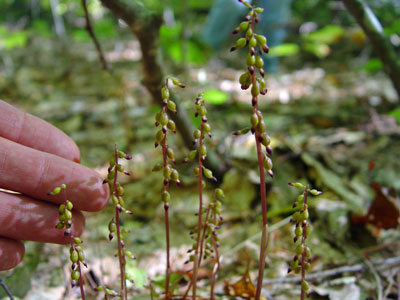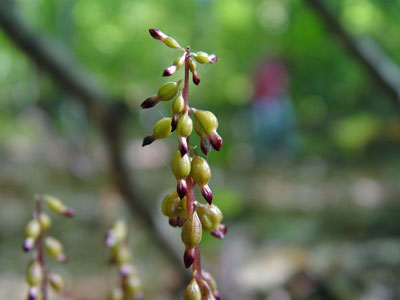DACF Home → Bureaus & Programs → Maine Natural Areas Program → Communities, Plants, and Animals → Rare Plants → Corallorhiza odontorhiza

Corallorhiza odontorhiza (Willd.) Poir.
Autumn Coral-root
- State Rank: S1
- Global Rank: G5
- State Status: Endangered
Habitat: Dry woodlands. [Hardwood to mixed forest (forest, upland)]
Range: Georgia to Mississippi, north to southwest Maine and west to Minnesota.
Aids to Identification: Coral-roots can be recognized by their saprophytic habit (plants with no chlorophyll and leaves reduced to small scales) and their erect, unbranched flower cluster (a raceme) bearing small, typically orchid-shaped flowers. Autumn coral-root can be distinguished from other Maine coral-roots by its entire (i.e. unlobed) lip and its small size: flowers only 3-4 mm long and entire plant usually only 10-15 cm high.
Ecological characteristics: All members of this genus are saprophytes, plants which live on decaying organic matter rather than manufacturing their own food from sunlight. Autumn coral-root is usually found in small depressions where there is abundant organic matter in the form of decaying leaves, etc. Little information is available on its ecological relationships

Phenology: Flowers July through August.
Family: Orchidaceae
Synonyms: Maine populations are represented by var. odontorhiza. Variety pringlei (Greenman) Fraudenstein is reported from Maine by Brown (1997), but MNAP has never tracked this taxon and specimens are unknown.
Known Distribution in Maine: This rare plant has been documented from a total of 6 town(s) in the following county(ies):Hancock, Oxford, York.
Reason(s) for rarity: At northern limit of range. Possibly overlooked?
Conservation considerations: Orchids are popular among some speciality gardeners, and populations of this species are vulnerable to unscrupulous or uneducated collectors. Plants dug from the wild usually do not survive; more importantly, removing these plants harms the natural population and may cause its eventual disappearance. This plant has not been successfully propagated, and any plants offered for sale have almost certainly been dug from the wild.